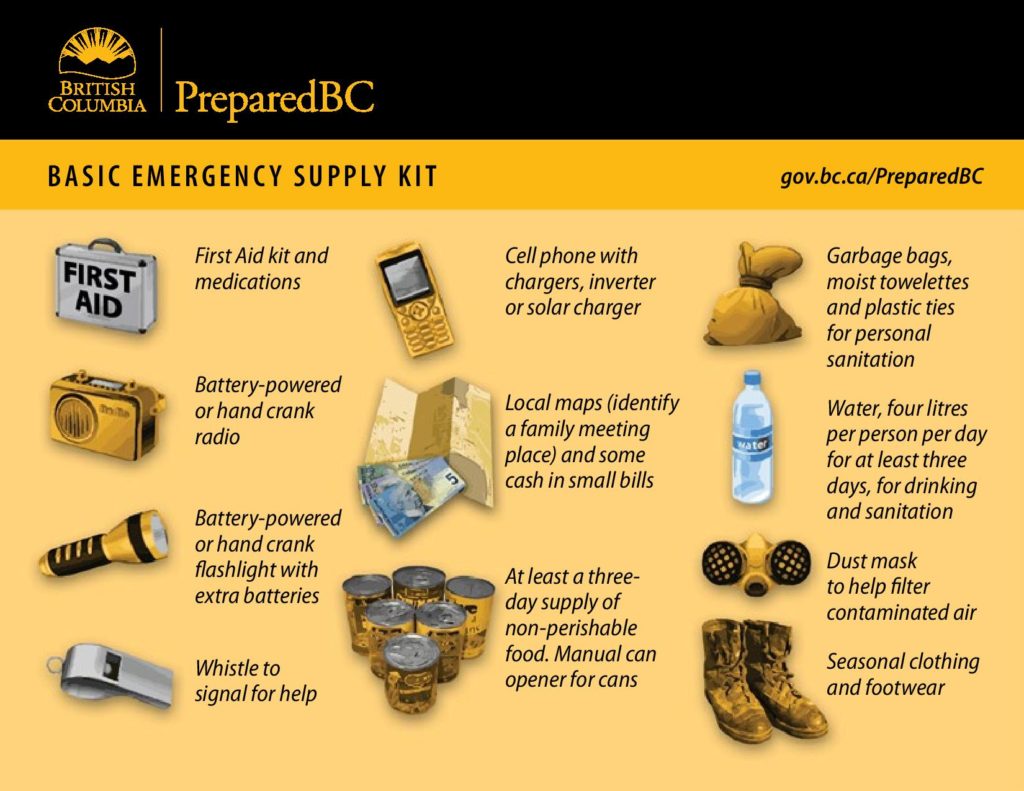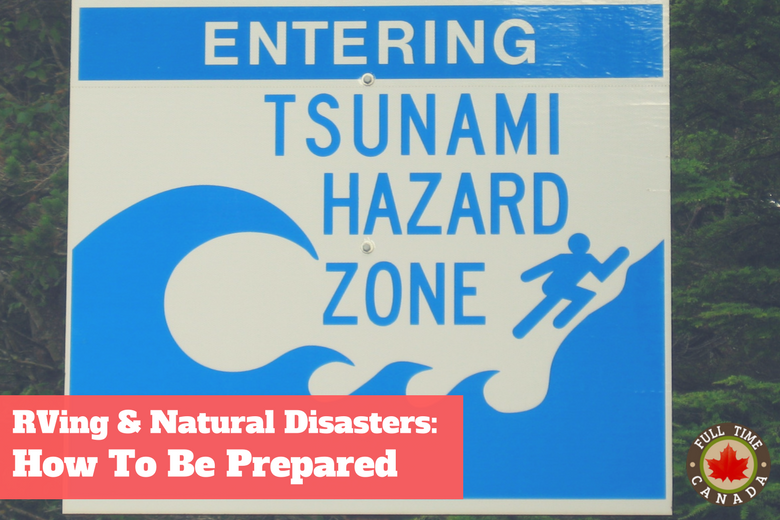My eyes open and suddenly I’m awake – wide awake. I look at the alarm clock. It reads 2.03am. I think, “Ugh, is this going to be one of those nights where I can’t get back to sleep?” I close my eyes, but as soon as I do I hear something odd, especially for the middle of the night. Off in the distance, I hear an alarm of sorts. Being that I was in a tired, groggy state of mind I had to focus to properly make out the strange alarm. Then I heard it clearly. I don’t exactly remember what it was saying, but surrounding the alarm was a statement that basically said, “This is a tsunami warning, please seek high ground.” After that moment, I was REALLY wide awake.
Quickly, I sat up, yelled at a sleeping Kate, “TSUNAMI WARNING!” Then it was go time. Hurriedly, we dressed, grabbed our 72-hour kit, shoved the cat in her carrier, woke the dog who didn’t want to wake up and drove to high ground at our local community centre.
For the next 2.5 hours, we sat in our truck at the community centre watching for updates to see if the 7.9 magnitude earthquake off the coast of Kodiak, Alaska was going to send a huge tsunami wave our way. Finally, around 4.40am, we learned that the coast was clear and that no tsunami was expected to pound our shores.
Watch as the crowd at the Tofino Community Centre celebrates the news that there would be no tsunami.
Great news! Downgraded from evacuation to advisory! Here’s the room @TofinoEmergency : #Tofino #Tsunami pic.twitter.com/1HczItaQed
— Catherine Lempke (@Cat_Lempke) January 23, 2018
Since arriving in Tofino in the fall of 2016, Kate & I have been educated over-and-over again about the dangers of living on the west coast due to the expected “Big One” earthquake & possible tsunamis. We’ve been told about how to prepare for such instances, but no amount of preparedness gets you ready for the real deal. The day after the tsunami warning we debriefed amongst ourselves & friends about whether we were truly prepared in the case of an emergency such as a tsunami. We realized that while we were decently prepared, we weren’t completely prepared. For instance, we packed cat & dog food in our 72-hour kit but no human food and I know Bella doesn’t like sharing her food.
The tsunami warning definitely opened our eyes and since then, we’ve been working towards being fully prepared for future emergencies, whether they’re tsunamis, earthquakes, or any other type of natural disaster. Each year we see a plethora of sad stories on RVing Facebook groups about natural disasters that wreak havoc in various parts of the continent. We’ve learned that we need to be ready for these disasters because you never know when they will strike. Below are some general ways you can prepare yourself & your RV for these unpredictable emergencies.
We’ve also included a downloadable link below to a great guidebook by Janice Wesley.
Know Your Surroundings
When you’re RVing and travelling all over the continent it’s easy to think only about having fun. However, in the back of your head, you always should be aware of your surroundings and what that could mean for the safety of you & your family. Whether it’s tsunamis & earthquakes on the West Coast, hurricanes of the East Coast, tornadoes of the Midwest, or any other natural disaster it’s wise to know your surroundings and how to prepare for them.
For example, here in Tofino, with the threat of earthquakes & tsunamis always in the back of our head, we have to know where high ground is and what the evacuation route is. A quick check on the District of Tofino website gives us the evacuation route for the town and the high ground locations including the community centre which functions as an Emergency Reception Centre. Wherever you’re RVing should have similar resources available to help you plan an evacuation if needed. If you can’t find an evacuation route, have a local map handy and map out your own routes or ask a local for advice.
Be Alerted
Being notified of a potential or ongoing natural disaster is something that could mean the difference between life and death as you never know how much time you truly have to evacuate during an emergency.
With our recent tsunami scare, because it happened in the middle of the night, there were many people who slept right through the warning sirens. The sirens, though, were just one way of being notified and there are many ways to prepare yourself for these types of natural disasters.
A lot of communities, provinces, etc… will have specific emergency notification systems in place. For us in Tofino, we used the One Call Now notification system. All you have to do is sign up with your phone number and in the case of an emergency the notification system will call you and let you know about the situation and what to do. It’s important to make sure you get those notifications after you sign up, as well which you can ensure by making sure those notification systems are added to “Emergency Bypass” in your contacts. That will make sure your phone rings even if your phone is in silent or do not disturb. Click here on how to use Emergency Bypass.
In the U.S., these alerts may automatically come to your phone through the cell carrier as was the case in the recent fake Hawaiian ballistic missile alert that went out. This technology will soon be coming to Canada as well.
Aside from alerts from various forms of government, you can get various apps on your phone to alert you of various events. Again, these will depend on where you are travelling but in our case, we’re now using the QuakeFeed app which alerts us to earthquakes within specific settings that we chose. This allows us to know about earthquakes happening on the West Coast and alerts us regarding their severity & possible need to evacuate.
We’re also receiving tweets from the National Tsunami Warning Center (@NWS_NTWC) in the U.S. directly to our text messages so we don’t ever miss a tsunami warning. Read about how to get tweets sent directly to your text message.
No matter where you are, the combination of local alert systems combined with your own alerts should have you always aware of natural disasters.
72-Hour Kits
It’s been long hammered into our heads that every home, no matter where you live, should have a 72-hour kit. These kits can assist in your survival should the necessary situation arise where you have to depend on the contents of such a kit.
Depending on where you’re travelling it could be wise to have enough contents for a week. If you’re RVing in a remote place or boondocking, you may be on your own for a while. This is one reason why it’s also wise to send your daily travel plans to someone and check-in at the end of the day.
So what do you put in a 72-hour kit? That really is the ultimate question. There are the obvious necessities such as food & water. But you also have to be smart about packing your kit. You may have to be mobile and a heavy kit filled with can foods isn’t the smartest choice. In terms of food, we recommend foods that are light & full of protein and carbs. We’ve recently packed turkey jerky, nuts, oatmeal & energy bars into our kit.
Instead of listing every little thing that you should have in a 72-hour kit, click this link for the list provided by the District of Tofino. A quick glance at the list shows a long list of items. We don’t have everything on that list in our kit and you don’t need to either. Once you go through it, you will realize what items are most important.
When packing your kit, we used vacuum sealed bags to separate the contents. This helps in two ways. First, it helps keep everything dry should we be caught in the water or in rainy conditions. It also helps keep your kit organized. For example, we have one vacuum sealed bag that we can transfer from our 72-hour bag to our camping/hiking bag as all the contents are useful in both situations.
It’s also important to have a kit in your vehicle because you never know when a natural disaster will strike and therefore you have to be prepared for when you’re not in your RV. For us, we bought a large tote and have filled it with the necessities along with extra food, sleeping bags & our tent.
When you’re creating your kit, don’t forget about your pets. Whether you create a separate kit for your pets or stash everything into your own, it’s good to have pet supplies ready. In our kit, we have food, extra leashes/harnesses, a Tupperware container for food, & doggy bags. We also keep the cat carrier right next to our 72-hour kit so we can quickly grab both.
If you don’t want to deal with the fuss of putting together your own 72-hour kit, there are plenty of companies and organizations selling them such as the Red Cross. Whether you build your own or buy one, get your 72-hour kit ready now because natural disaster can happen anytime.
Be sure to remind yourself to check the contents of your kit every 6 months to a year for expired items and restock as necessary.
Natural Disasters & RVing
All the above information is good knowledge to have regardless whether your travelling the country in your RV or you’re stationary. Because a natural disaster can happen while you’re RVing you must be prepared for the nuances that come with that scenario.
Evacuation. The type of RV you have and the type of natural disaster you could be facing cause an interesting scenario. In some situations, you may be able to get into the driver’s seat of your motorhome and take off. If you have a fifth wheel, you probably will be leaving it behind unless you have plenty of time to evacuate. Be mindful of where you might be heading in your RV as well as you may not be able to go far with a large vehicle. For instance, here in Tofino, our small town would be bogged down quickly with RVers and everyone would have to be on foot to reach high ground in the case of a tsunami.
Water. In the case of a prolonged emergency, water is usually the most important thing to have. Thankfully, with an RV you have a built-in freshwater tank. Keeping if full will always ensure you have a supply of water should you be able to be able to safely remain with your RV.
Solar Power. These days more and more RVers are installing their own solar panel system as a way to stay powered when they boondock. This also comes in handy when you’re dealing with an emergency and power isn’t available. Solar systems are getting cheaper these days and are relatively easy to install.
Fuel. It’s always a good idea to make sure your motorhome or tow vehicle has plenty of gas. A good rule of thumb is to fill up when you reach half a tank. This will allow you to travel a good amount of distance should you need to in the case of an emergency.
Propane. Two full tanks of propane can last both keep you warm and allow you to cook food in the case of an emergency. Make sure you always have at least one full tank of propane. A good rule of thumb is to fill one tank soon after it runs out.
Finding Shelter. In the case of hurricanes or tornadoes, it could be important to leave your RV immediately and find shelter. If you’re staying at a campground, this could mean heading to the bathroom, laundry facilities, main office or some other designated building. When checking into a campground, ask them about their emergency shelters.
Check On Your Neighbours. If you’re in an RV park, your neighbours (for whatever reason) may not be aware of the current emergency unfolding. If time permits, check on them to make sure they are OK and are aware of everything that is going on.
While we rather would not have had to deal with a tsunami scare to learn and prepare ourselves for a natural disaster, we now can say that we’re ready or at least as ready as we can be. There are so many variables when it comes to a natural disaster and it’s hard to be prepared for every situation but the best thing you can do is be overprepared. Have a 72-hour kit. Know your evacuation routes. Sign up for alerts.
Further Reading: Recreational Vehicle Emergency Preparedness by Janice Wesley https://goo.gl/6Tq1bC

